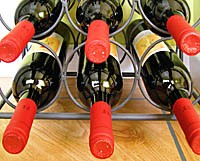My wife told me that publishing this would be like sending out one of those braggardly “family newsletters” to one’s friends, but I wanted to round off the blog for 2012 by posting a few memories from the year…is that so bad? I even blogged about not posting it. Anyway, it’s New Year’s Eve, no one will be reading this.
I also just ported my snaps from Instagram to my Flickr account and those photos should act as personal mementos for what has been a rather busy year for us with several highlights and several lows (which I’m not going to list here, you’ll be pleased to learn). Anyway, I’m finalising this on 20/12/2012, the day before the Mayan Apocalypse, if you’re reading this, then we must have survived…
Anyway, here’s the Instagram link on Flickr to my collection of snaps from this year.
Took in the David Hockney “The Bigger Picture” exhibition at the Royal Academy London.
Attended a bloggers’ breakfast at Buckingham Palace for the launch of the Leonardo da Vinci Anatomist exhibition.
Took a tour of the Classic FM studios with presenter/creative director Tim Lihoreau. Met my book publisher at the Wellcome Trust.
Took part in a medical research study in Cambridge.
Climbed Derbyshire’s Lose Hill in the snow and slid some of the way back down.
Saw and photographed The Cotswolds for the first time.
Helped promote the first sellout Custard Comedy gig in Cottenham.
Watched a good friend play Amundsen in The Bawds production of Terra Nova at the ADC Theatre
Visited the Sanger Centre on the Genome Campus.
Started playing bass guitar after 34 years of being a 6-string guitarist.
Attended a STEMPRA training day.
Attended a 60th birthday party.
Watched the Cambridge University “Bumps” from the river bank at Ditton Corner.
Took part in the UK Conference of Science Journalists.
Joined hundreds of other singers at the Royal Albert Hall London to perform two choral works by Karl Jenkins.
Swam in the chilliest indoor swimming pool ever courtesy of Anne and Julian.
Hosted a German exchange student with the family and sent our daughter off to Germany for the reverse trip.
Camped in the wettest weather imaginable during the Diamond Jubilee weekend.
Took in some Olympic events at the Olympic Park (men’s hockey prelims).
Wrote a book (Deceived Wisdom, published by E&T, 8th November, ultimately a bestseller was ahead of Prof Brian Cox and Sir David Attenborough in the Amazon charts for at least a week)
Visited Brighton (third time)
Visited Liverpool (third time)
Visited Leeds (first time!)
Did my second-ever poetry reading to an invited audience (a poem about Stiffkey in Norfolk)
Helped kickstart an Arts Night at our local, volunteer-supported community centre in the April. UPDATE: This regular event eventually got me to the point where I’d pulled a band together, C5, still going strong to this day and having played dozens of pub gigs, several festival events, parties, and fundraisers.
Wrote what seems like an awful lot of science and technology news and features for various publications.
Published almost 300 blog posts on Sciencebase.
Passed 22,000 Twitter followers. (10y UPDATE: I reached 55k at the peak, but it’s down to about 40k now at the point where Elon Musk has taken over)
Wrote and performed solo a self-penned song to a select group of friends.
Celebrated 20 years of happy marriage to Tricia.
Celebrated our son’s 18th birthday and our daughter’s 15th.

 In my book, one of the myths I debunk is that surrounding the etiquette of removing the cork from a bottle of red wine to allow the wine to “breathe”. It’s clearly nonsense as the air-liquid interface is too small to have any significant effect. There are some claims that aeration either through decanting or whizzing the wine through an aerator device might have some effect on the aroma and taste by inducing oxidation. Again, that’s a myth as the rate of oxidation even when bubbling air through wine would require two to three days to have any effect.
In my book, one of the myths I debunk is that surrounding the etiquette of removing the cork from a bottle of red wine to allow the wine to “breathe”. It’s clearly nonsense as the air-liquid interface is too small to have any significant effect. There are some claims that aeration either through decanting or whizzing the wine through an aerator device might have some effect on the aroma and taste by inducing oxidation. Again, that’s a myth as the rate of oxidation even when bubbling air through wine would require two to three days to have any effect. A conversation on Facebook where I highlighted Freeny’s model of the internal organs of The Very Hungry Caterpillar, reminded me of an incident with our pet labrador that happened a couple of years ago.
A conversation on Facebook where I highlighted Freeny’s model of the internal organs of The Very Hungry Caterpillar, reminded me of an incident with our pet labrador that happened a couple of years ago.